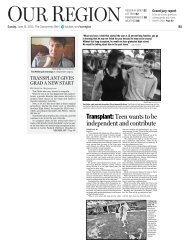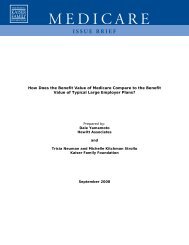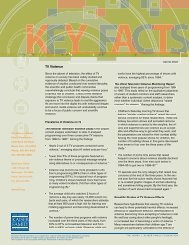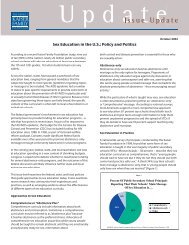HEALTH CARE COSTS: A PRimER - The Henry J. Kaiser Family ...
HEALTH CARE COSTS: A PRimER - The Henry J. Kaiser Family ...
HEALTH CARE COSTS: A PRimER - The Henry J. Kaiser Family ...
You also want an ePaper? Increase the reach of your titles
YUMPU automatically turns print PDFs into web optimized ePapers that Google loves.
Key Facts<br />
� In 2010, the U.S. spent $2.6 trillion on health care, an<br />
average of $8,402 per person.<br />
� <strong>The</strong> share of economic activity (gross domestic product, or<br />
GDP) devoted to health care has increased from 7.2% in<br />
1970 to 17.9% in 2009 and 2010.<br />
� Health care costs per capita have grown an average 2.4<br />
percentage points faster than the GDP since 1970.<br />
� Since 2002, the rate of increase in national health care<br />
spending has fallen from 9.5% to 3.9%.<br />
� Half of health care spending is used to treat just 5% of the<br />
population.<br />
� Although only 10% of total health expenditures, spending<br />
on prescription drugs has received considerable attention<br />
because of its rapid growth (114% from 2000 to 2010).<br />
� In 2008, 27% of the nonelderly with 3+ chronic conditions<br />
spent more than 10% of their income on health, compared<br />
to 11% of the total nonelderly population.<br />
� Many policy experts believe new technologies and the<br />
spread of existing ones account for a large portion of<br />
medical spending and its growth.<br />
Introduction<br />
Health care accounts for a remarkably large slice of the U.S. economic pie. Each year<br />
health-related spending grows, virtually always outpacing spending on other goods and<br />
services, meaning that the size of that slice increases. <strong>The</strong>se cost increases have a<br />
significant effect on households, businesses, and federal, state, and local<br />
governments. Among other things, rising health care costs make health insurance less<br />
affordable for individuals, families, and businesses; put pressure on businesses that<br />
offer insurance coverage to their employees; can be a major financial burden to<br />
families, even those that have insurance; and can result in individuals not receiving the<br />
health care services they need. For taxpayers, government programs such as<br />
Medicare and Medicaid are major parts of federal and state budgets, and increasing<br />
costs require either additional revenue or reductions in benefits, eligibility, or payment<br />
rates.<br />
Concerns about rising health care costs and affordability of health care for families<br />
persist despite the enactment of comprehensive health reform legislation in March<br />
2010 (the Affordable Care Act, or ACA). 1 <strong>The</strong> ACA changed the health care landscape<br />
considerably by providing significant financial assistance to help people with low and<br />
moderate incomes afford coverage and associated cost sharing. <strong>The</strong> law provides new<br />
standards for private health insurance, including identifying minimum benefits for health<br />
insurance, placing limits on cost sharing for covered benefits, and establishing new<br />
rules for private health insurance that assure access to coverage for people with health<br />
problems and limit premium and contribution differences based on health-related<br />
factors. Together these provisions will dramatically reduce financial burdens for many<br />
people with lower income or significant health care needs.<br />
<strong>HEALTH</strong> <strong>CARE</strong> <strong>COSTS</strong>: KEY INFORMATION ON <strong>HEALTH</strong> <strong>CARE</strong> <strong>COSTS</strong> AND THEIR IMPACT<br />
1












